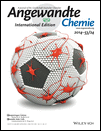Laboratory Real-Time and In Situ Monitoring of Mechanochemical Milling Reactions by Raman Spectroscopy†
The LS2 laser source used in this study was kindly donated by PD-LD Inc., Pennington, New Jersey (USA). We are grateful to Dr. Manda Ćurić for support and discussions, Dr. Dejan-Krešimir Bučar for critically reading the manuscript, and Vitomir Stanišić for help with the grinding jars. The Ministry of Science, Education and Sport of the Republic of Croatia (Grant Nos. 098-0982915-2950, 098-0982904-2953, 098-0982933-2920, 098-0982886-2894) and the Unity through Knowledge Fund (UKF), Grant Agreement No. 7/13 are acknowledged for financial support.
Graphical Abstract
Out of the dark: Mechanochemical reaction mechanisms were studied by a laboratory Raman spectroscopy technique developed for in situ and real-time monitoring of milling reactions (see picture). The technique enabled the course of mechanochemical transformations of coordination polymers and organic materials to be followed as well as the study of liquid additives.
Abstract
Mechanistic understanding of mechanochemical reactions is sparse and has been acquired mostly by stepwise ex situ analysis. We describe herein an unprecedented laboratory technique to monitor the course of mechanochemical transformations at the molecular level in situ and in real time by using Raman spectroscopy. The technique, in which translucent milling vessels are used that enable the collection of a Raman scattering signal from the sample as it is being milled, was validated on mechanochemical reactions to form coordination polymers and organic cocrystals. The technique enabled the assessment of the reaction dynamics and course under different reaction conditions as well as, for the first time, direct insight into the behavior of liquid additives during liquid-assisted grinding.





